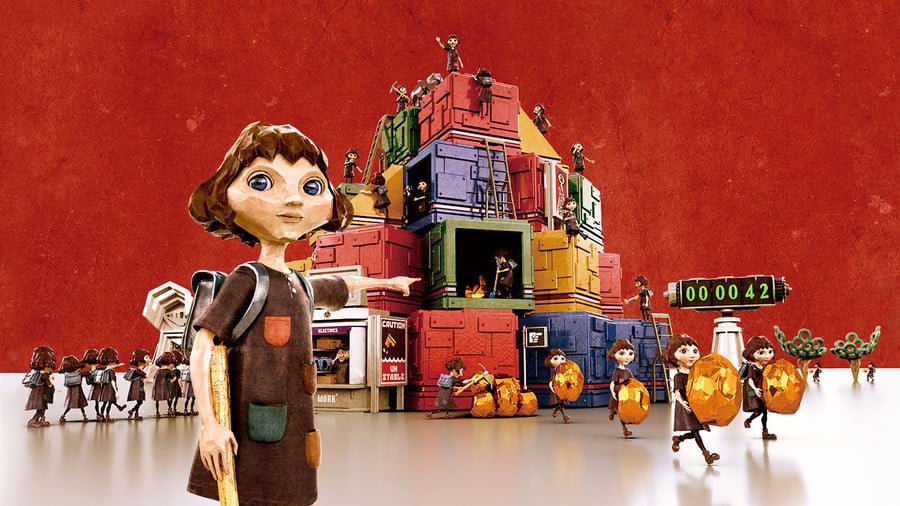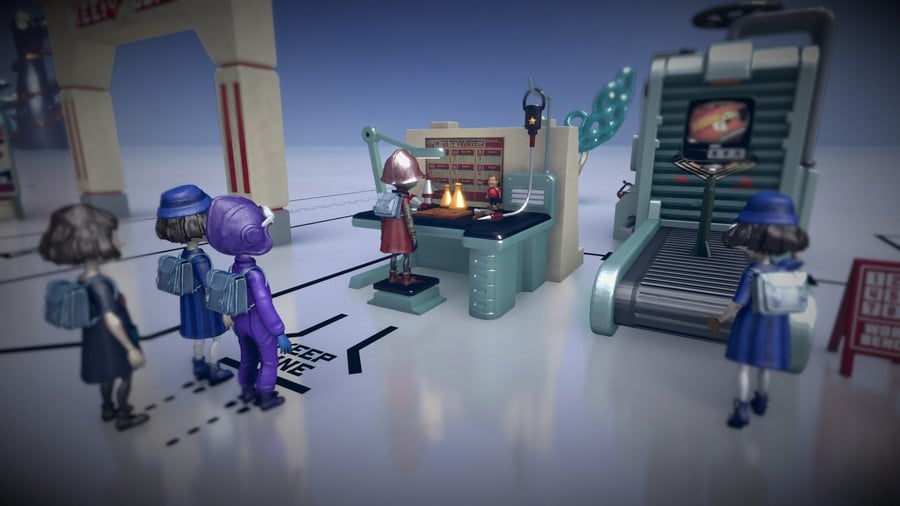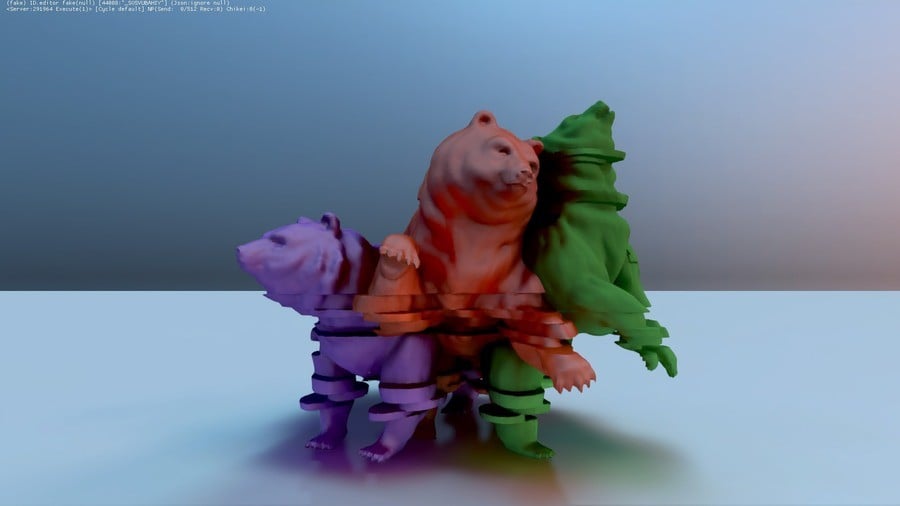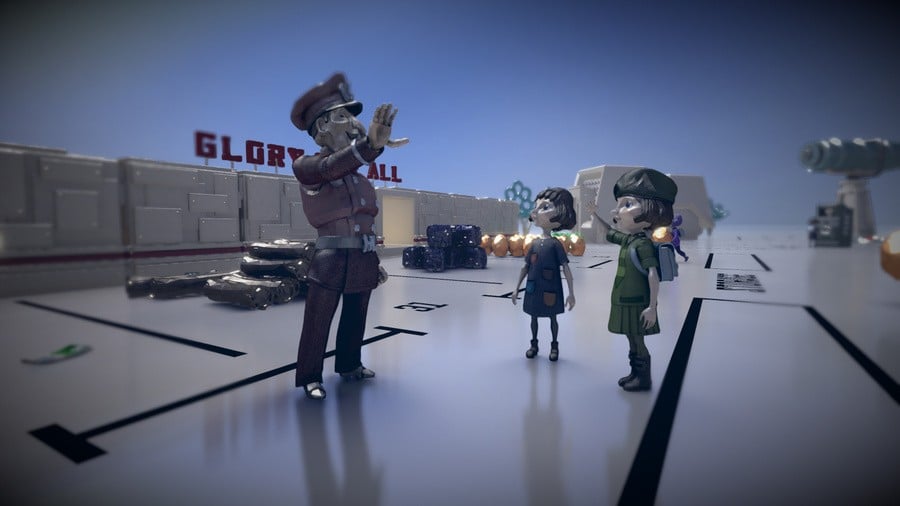

One of Sony's finest qualities as a games publisher is its willingness to take a gamble on new ideas. Each PlayStation console has played host to a variety of weird and wonderful games, and early in the PS4's life, this philosophy of embracing experimental, unique concepts didn't waver. A prime example is The Tomorrow Children. Developed by Q-Games, the Kyoto-based studio perhaps best known for its PixelJunk titles, this new game seemed like a step into something unknown and rather fascinating. The game's fifth anniversary is upon us, and so we wanted to mark the occasion with a look back at this unusual PlayStation exclusive.
Announced at Gamescom 2014, The Tomorrow Children was an online co-op title about little wooden dolls working together to rescue humanity. To achieve this, you would establish small towns atop The Void and slowly increase its population by mining for precious resources, keeping the settlement powered, and protecting it from any threats. Otherworldly structures would appear from the grey landscape around you, and you could find all kinds of valuable stones and other items out there — but you had to work alongside other "projection clones" in order to get everything back to base and then put it to good use. With a veneer of Soviet-era stylings finishing it off, there was — and still is — nothing quite like this game.
"I based [The Tomorrow Children] on memes and concepts from my childhood, living in the UK, with the Cold War as a backdrop," Dylan Cuthbert, president and founder of Q-Games, tells us. "I grew up with TV shows and movies such as The Prisoner, From Russia with Love, and Firefox. More recently, I got interested in Czech puppetry and the history of the Czech Republic, so I thought I would combine them all to set up the stage for The Tomorrow Children’s alternate timeline."

It certainly made for a unique look and feel. Despite the camaraderie of working alongside other players towards an ultimate goal, the game emitted a sinister, creepy, almost oppressive atmosphere. Combining an extremely minimalist environment with bizarre creatures and Soviet propaganda, the presentation was strange to say the least, but that was all part of the brief. Mark Cerny had tasked Q-Games with making something "a little outside of the box", and it certainly did.
While it was a move away from PixelJunk in some respects, Cuthbert says it wasn't a giant leap for the team: "Q-Games had always been doing 3D games and technology, so The Tomorrow Children wasn't so different from what we were already doing," he says. "The PixelJunk series at the time was focused more on the high-resolution 2D experience, so instead, we decided to really focus on showcasing the power and graphics hardware of the PlayStation 4. The Tomorrow Children allowed us to take some risks with cutting-edge rendering paradigms unlike most of the AAA titles."
Indeed, the game had a very particular art style, and some of the visual effects were surprisingly realistic. As Cuthbert remembers the game today, he looks back at it with "great pride and fondness" and comments that the graphics "haven’t aged at all, and I think it would look right at home even on a PlayStation 5".

During the game's development, Q-Games artists travelled to the Czech Republic "to study puppets and puppet making, and to go to one of the theaters where you can see the puppets in action performing a play," Cuthbert tells us. "I think these kinds of field trips can give huge amounts of inspiration to a team and the team seemed to really enjoy themselves and brought back all kinds of cool ideas."
An experiment part way through development helped bring a new perspective to the project: "Also, in order to refresh the game design, about a year or two into the game we did a short multiplayer experiment where each player was a bird living on the islands out in the void," he says. "The idea was that you could fly from tree to tree, forage for food and fly in formation with other players. It was a good refresh and the collaborative elements and feeling of altruism from that demo was then brought into The Tomorrow Children at a critical stage in its development."
The game would eventually launch on 6th September 2016, moving to a free-to-play model about a month later. Critics (including ourselves) had mixed feelings about the game, praising its visuals, unique concept, and working together with other players, but the repetitive workload proved to be contentious. There were also several technical hiccups in its first weeks. Despite any problems, The Tomorrow Children attracted a small but loyal player base — but this ultimately wasn't enough to keep the lights on.

"We launched with a lot of lag on the server, and it took a few months to clear up, unfortunately," Cuthbert recalls. "I feel we should have launched the game as 'Early Access' for the first year, sorted out all the technical issues with a core fan base, and then expanded to a wider audience. We might have figured out what works and doesn’t work for a free-to-play game by that point too, giving the game a fighting chance to earn enough to run the servers."
Sadly, the fascinating game wouldn't last very long. Its cooperative multiplayer features and unique world set it apart, but Sony made the decision to shut the game down. On 1st November 2017, just over a year after launch, The Tomorrow Children was taken offline.
Cuthbert says it felt like the game's fate was sealed pretty quickly: "I can’t be sure, but it felt like the decision [to shut the servers] was made very early on after launch when we didn’t sell enough copies in our first few months, and also because we had retention problems for the first few months as we tuned the experience."

He continues: "We couldn’t iterate and update the game fast enough either, because all the systems in place to patch games on the PlayStation Network were designed for safety and not speed, but in the free-to-play space you need to be nimble. So we launched, and about five months later were told to begin the process to shut it down because the monthly earnings weren’t covering the cost it took to run and maintain the servers. This was very upsetting, but by that time I didn’t have any fight left. So we put on a brave face and made some awesome final updates to the game while we could."
Naturally, as the game was shuttered so swiftly, a bunch of planned updates and content never made it into The Tomorrow Children. A "giant red robot" was going to be a defensive force you could build, "and then use to take on the Izverg (monsters) directly". Cuthbert says the team "also had story reveals and set pieces planned too, and you can hear the music for one of those in the released soundtrack".
We asked Cuthbert how the game might be received if released today, and how he and the team might do things differently if given the opportunity. "I think if it was re-released, and we tuned the game away from free-to-play, it could pique everyone’s interest again," he muses. "It’s difficult to say though, because the whole atmosphere of camaraderie appeals to some people, and not to others."

So, what would Q-Games do if making the game in 2021? "I would remove the free-to-play elements and the reliance on a server," Cuthbert says. "Instead, I would make the game peer to peer, similar to Minecraft, with the players themselves hosting a town for others to join via party play codes or direct invites."
Looking to the future, Cuthbert hasn't lost faith in The Tomorrow Children or its concept. In fact, he tells us he'd be interested in revisiting its universe with a follow-up. "We don’t have anything planned immediately, but one day I’d like to create a sequel based in 'Freeman Land' (where all the Freeman Dollars come from). It would be based in the deep south of a post-apocalyptic USA, where only robots and androids now exist, and they would all be involved in a very strange religion..." It certainly sounds intriguing to us.
While it's a real shame that the game didn't survive, it managed to leave a lasting impression beyond its 12 months of activity. Sony does like to take risks, as we mentioned earlier, and not all of them are going to pay off. However, The Tomorrow Children still feels like a real moment in PS4's lifespan, and an important game for Q-Games. Cuthbert carries forward a lesson that'll resonate with anyone in a creative field: "If you stick to your guns and persevere, you really can make something that is truly unique and different from everything else out there." That was certainly true for this game, and even though it's lost to the void, we won't forget it in a hurry.
A big thank you to Dylan Cuthbert and Q-Games for taking the time to work with us on this feature. The Tomorrow Children is no longer available, but in celebration of its fifth anniversary, the developer has played an old build of the game, with a video live right now on IGN Japan. What are your memories of The Tomorrow Children? Reminisce in the comments section below.





Comments 17
It was a sublime game, fact.
5 years?! Time does indeed fly fast!
Wow, memories. I loved this game so much, bring it back Sony... I'll pay for it again.
I remember seeing this on its first reveal and thinking it looked amazing. Really refreshing visuals. But unfortunately just did not click with it when I eventually played it.
Only 5 years old and the games no longer available anywhere that its own Dev has to play an old build of it? That really isn't a good sign. 5 years is nothing.
Thanks for this article, lovely read and indeed quite a special game when it launched.
I was interested in this and gave it a try (I think both in a beta and again after it was free), but he was right - there were issues with lag and connectivity early on, and while I found it interesting I just didn't stick with it.
I remember Sony hyped the heck out of it for months leading up to the release, and maybe for a little while after, but they seem to make decisions early on after release, and it showed. I remember the promotion dropped to nothing for this, and they Sony hype engine moved on to the next big thing they were pushing.
I remember the reveal and really wanted to play it but somehow missed the launch it went offline before I ever had a chance to try.
Ugh...this game. I tried it, but found my mining materials were being used up for junk and no one wanted to generate power. Then the monster trashed our village and I quit.
If I remember correctly, Digital Foundry claimed this game used a rudimentary form of software-based ray tracing (or something like it) on the PS4, years before hardware-based ray tracing became a thing. Very interesting stuff, if you're into the tech angle of game development.
This game was promising...then it fell flat on its nose. Supreme art style marred by technical issues, great gameplay idea destroyed by unimaginative execution. Last minute switch to free to play model just made it worse. Such a shame and disappointment. Let it be, dead and buried. Do something else.
This game was real and not some fever dream i had? On top of that according to my trophies I played it before but have no memory of it.
Creative, passionate and personal things like this die while the rotting, giant carcass of FIFA (and its ilk) shudders on, like a shadow over the industry, with the sole purpose of getting children addicted to gambling. What a time to be alive.
That was a lovely looking game, lighting was sublime, no idea what was going on though.
I remember playing the early beta and it was very weird, but absolutely had promise.
I think the biggest problem was it’s launched which was almost no existent in terms of marketing. I remember seeing it a while after release on the store, and thinking “oh wow this came out”.
Real potential here which I think a game like Dreams, can help rebuild with similar ideas.
I loved the art style when I played but I just didn't like the gameplay loop.
Took me forever just to figure out where and how to buy items that were than used up far too quickly :/
It was cute but those monsters were a pain if I remember correctly.
Honestly just didn't "get" this game. I love Q-Games, bit this one never clicked for my somehow. Still, I want to see more stuff like this!
Please make it come back!!!
Tap here to load 17 comments
Leave A Comment
Hold on there, you need to login to post a comment...